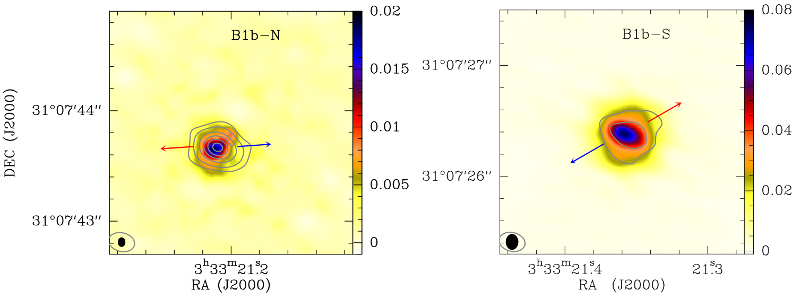| EPoS Contribution |
|
Nascent Disks in the First Hydrostatic Core/Class 0 archetypes B1b-N and B1b-S
Maryvonne Gerin LERMA, Obs. Paris, Paris, FR | |
|
A key issue in the early stages of star formation is the epoch of
formation of a
rotationally supported disk. While disks are commonly observed during the
later stages of
star formation, i.e. class I, class II or T Tauri phase, disks are
difficult to observe
during the class 0 phase and their occurence and properties are much less
constrained.
Theoretically, the epoch of the formation of protostellar disks is
debated, because of
the competing roles of rotation and magnetic fields at the early stages of
low-mass star
formation. Magnetic braking could prevent the formation of rotationally
supported disks
in strongly magnetized cores if the rotation axis is aligned with the
magnetic field.
Nevertheless, disks are predicted to form in magnetized cores, thanks to
the combined
effects of non ideal magnetohydrodynamics (MHD) and misalignment between
the rotation
axis and the magnetic field orientation. High spatial resolution (< 10 au)
studies of
individual sources are needed to establish the epoch of disk formation for
different
geometries.
The extremely young Class 0 object B1b-S and the candidate to First Hydrostatic Core (FSHC), B1b-N, provide a unique opportunity to study the earliest phases of star formation. Both objects are located in Barnard 1b, a well known dark core in the Perseus molecular cloud complex at a distance of 230 pc. First classified as FSHC candidates on the basis of their SED, these sources have been shown to launch low velocity outflows (< 10 km/s) with dynamical times, mechanical luminosities and mass-loss rates consistent with theoretical predictions for Class 0 (B1b-S) and FSHC (B1b-N). Additional observations of the NH2D 1(1,1)a-1(0,1)s line at 5" resolution have unveiled a rotating structure around B1b-S that we interpret as the the pseudo-disk predicted by MHD simulations. ALMA images of the 350 GHz continuum emission with < 0.1" (20 AU) resolution show bright (> 30K ) and compact sources with sizes of 46 au (for B1B-N) and 80 au (for B1b-S) sitting on top of a more extended emission. The morphology, temperature and densities of these compact sources are consistent with those of the disks predicted by MHD simulations of collapsing cores. New spectroscopic ALMA data reveal a hot corino in B1-S, while no comparable emission is seen in B1b-N, supporting its very early evolutionary stage (FHSC). Thanks to the extensive observations available, the physical and chemical structure of B1b-N and B1b-S are well constrained. These sources are therefore excellent prototypes for the first evolutionary stages of collapsing cores, that can be compared with state of the art models and simulations. | |
 | |
| Caption: Continuum emission at 349 GHz toward B1b-N (left) and B1b-S (right) at 0.1" with ALMA. The gray contours show the 32 GHz continuum emission from the VANDAM survey and are drawn at 0.05, 0.1, 0.2, 0.3, 0.4, and 0.5 mJy/beam. The ALMA and VLA beam sizes are shown as black and gray ellipses. The red and blue arrows show the approximate direction of the outflows. The PA of the projected rotation axis in B1b-S is PA=130. | |
| Collaborators: N. Marcelino A. Fuente J. Cernicharo E. Chapillon A. Ciardi, B. Commercon D. Lis J. Pety E. Roueff H.A. Wootten |
Key publication
Suggested Session: Cores |

